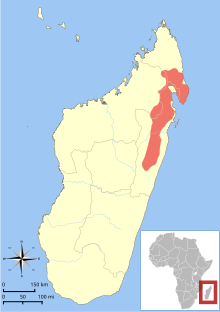Allocebus trichotis
| Hairy-eared dwarf lemur | |
|---|---|
 |
|
| Scientific classification | |
| Kingdom: | Animalia |
| Phylum: | Chordata |
| Class: | Mammalia |
| Order: | Primates |
| Suborder: | Strepsirrhini |
| Family: | Cheirogaleidae |
| Genus: |
Allocebus Petter-Rousseaux and Petter, 1967 |
| Species: | A. trichotis |
| Binomial name | |
|
Allocebus trichotis (Günther, 1875) |
|
 |
|
| Hairy-eared dwarf lemur range | |
| Synonyms | |
|
Cheirogaleus trichotis Günther, 1875 |
|
Cheirogaleus trichotis Günther, 1875
The hairy-eared dwarf lemur (Allocebus trichotis), or hairy-eared mouse lemur, is one of the most scarcely known lemurs.A. trichotis is a nocturnal lemur that is endemic to Madagascar. It was originally named by Dr. Albert Günther in 1875 as Cheirogaleus trichotis as part of the Cheirogaleidae family, or the dwarf lemurs. However, in 1967 Petter-Rousseaux and Petter reassigned the lemur to its own genus and is the now only member of the genus Allocebus. The hairy-eared dwarf lemur was thought to be extinct until its rediscovery in 1989 in a northeastern primary lowland rainforest. The population of these mammals is shown to be severely decreasing and largely fragmented throughout Northern and Eastern Madagascar rainforests; most likely due to hunting, trapping, slash-and-burn agriculture as well as habitat fragmentation.
Allocebus trichotis is thought to have been discovered as early as 1875 by Dr. Albert Günther. The species was initially only studied from 5 museum specimens that are housed in 3 collections in various locations in London, Paris and Stockholm and was thought to be extinct in the wild. The hairy-eared dwarf lemur was then rediscovered in the wild in 1989 by Bernhard Meier when a small population was found in Northern Madagascar in a remote primary lowland rain forest. Researchers have also discovered the species living in a primary highland rainforest in eastern Madagascar in a very popular tourist location, Andasibe, Vavatenina. Small populations, as few as one A. trichotis, have also been located in other areas of Madagascar; indicating a more widespread distribution than previously thought.
With the rediscovery of the hairy-eared dwarf lemur, new information regarding its physical description was obtained by Meier and Albignac when a small population was captured and observed in captivity. Information from the discovery of the lemur in an eastern rain forest has also been noted. Robin Lee Kolnicki describes Allocebus as a slightly larger Dwarf lemur; recent studies show the species weighs anywhere between 75-98 grams and anywhere from 125–145 mm head and body length to 150–195 mm head-to-tail length. Males and females have been shown to be similar in size and appearance. Hairy-eared dwarf lemurs can be distinguished easily from the other dwarf lemurs due to their very short, rounded ears with tufts of long, wavy hairs that project above the ear pelage; which are thought to be sensory hairs. There is an area of a darker grey triangle on their heads between their eyes and both of their eyes have dark narrow rings around them. Their nose and lips are a light pink color, and they exhibit an extraordinarily long tongue compared to other dwarf lemurs. The dorsal side of the lemur is a brownish grey, with a darker line of fur running along the spine. Their underbellies are grey, with the hairs ending in a white tip. Their hands and feet are a light rosy pink color, with long narrow nails protruding from them. The fur on their tails is short and becomes darker towards the tip. Little is known about the life span of the species, but other species in the similar genus Cheirogaleidae are thought to live around 15–19 years in captivity.
...
Wikipedia

